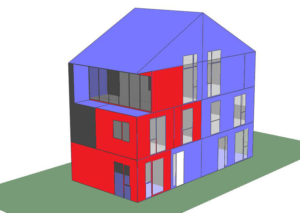Overheating is becoming a significant issue in new buildings, especially homes.
Studies by The Good Homes Alliance and the Zero Carbon Hub have shown that ever warmer, more airtight homes are posing serious risks to health and in some extreme cases, causing fatalities. Recent June 2022 changes to the building regulations have introduced a new Part O to set out how designers and contractors should approach overheating.
Overheating Analysis (also known as thermal comfort analysis) can predict risks, inform designers and developers, and improve the indoor environment for occupants.
The continual drive to deal with climate change has meant we are building warmer and warmer homes in winter. But the effects of inadequate ventilation, high solar gains and increased air tightness means those same homes respond poorly through the summer months.
How is Overheating Analysis performed?
Overheating analysis is typically performed using Dynamic Simulation Modelling (DSM) software which can analyse the occupied spaces and assess performance against criteria set by CIBSE (Chartered Institute of Building Services Engineers).
There are several instances where overheating analysis may be required:
- To provide thermal comfort credits within a BREEAM Assessment
- To achieve industry standards for thermal comfort i.e healthcare and education
- Where designers want to reduce risk of overheating
- To design-out overheating risks in dwellings identified by SAP Calculations
- As requested as part of the planning application
Some dwellings in particular carry a higher overheating risk – for example, highly glazed south facing, single aspect apartments with limited cross ventilation. Planning officers may identify such dwellings as high risk and request a report within a Sustainability Statement or Energy Statement.
Overheating Analysis – CIBSE guidance
The CIBSE Technical Memorandums provide the guidance for overheating or thermal comfort analysis.
Traditionally the CIBSE TM52 (The Limits of Thermal Comfort:Avoiding Overheating in European Buildings 2013) guidance has been used. TM52 outlines three criteria – a room or building that fails any two of the following three criteria is classed as overheating:
- The number of hours that the operative temperature can exceed the threshold comfort temperature
- The severity of overheating within one day – this is function of both temperature rise and it’s duration
- An absolute maximum daily temperature for a room, beyond which the level of overheating is acceptable
 More detailed information about using simulation to predict the danger of overheating is available in CIBSE Guide A. CIBSE KS16: How to manage overheating in buildings.
More detailed information about using simulation to predict the danger of overheating is available in CIBSE Guide A. CIBSE KS16: How to manage overheating in buildings.
In recent years further guidance as been released in the form of CIBSE TM59 (May 2017) specifically addressing overheating risk in homes, and also within CIBSE TM49 which provides current and future weather data for London boroughs.
Depending on your particular scheme and requirements, your assessor will use the most appropriate method of modelling the building.
Would you like to discuss your project?
Call us on 0330 055 34 05 or email be@buildenergy.co.uk.
